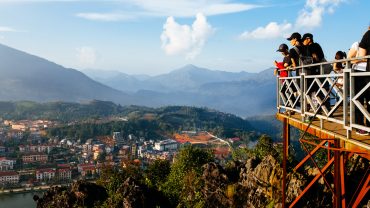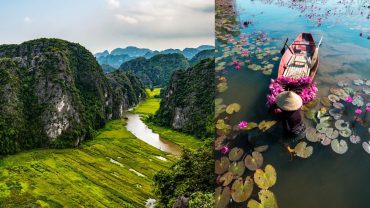Tucked away in the bustling cityscape of Ho Chi Minh City lies Khanh An Monastery, a sacred oasis embodying the beauty and tranquility of traditional Japanese temple architecture. Known for its unique design that merges Vietnamese and Japanese influences, Khanh An Monastery has become a must-visit for those seeking a peaceful escape from the city’s fast pace. In this article, we’ll explore the monastery’s history, architecture, cultural significance, and travel tips to help you fully experience this captivating destination.
Khanh An Monastery in Saigon: An Overview
Located in District 12, Khanh An Monastery in Saigon (Ho Chi Minh City) is often called the “Little Japan” of Vietnam, thanks to its Japanese-style temple design. While it may appear like a scene from Kyoto, this Buddhist temple holds Vietnamese spiritual traditions at its core. The monastery was initially founded in 1905, primarily serving as a place for spiritual practice and meditation. Since its renovation, it has transformed into a unique blend of Japanese aesthetics and Vietnamese Buddhist culture, attracting local and international visitors alike.
A Brief History of Khanh An Monastery
The story of Khanh An Monastery dates back to its founding in the early 20th century. Its founder, monk Tran Van Thanh, sought to establish a place of worship that fostered peace and compassion. While the temple was initially designed with Vietnamese architecture, the 2006 renovation took inspiration from Japan’s Buddhist temples, creating the design that we see today. The goal was to bring a touch of Japanese Zen to the area, which aligns well with the Buddhist philosophies that promote calmness and mindfulness.
[image-1|khanh-an-monastery-exterior|Khanh An Monastery Exterior|A wide shot of Khanh An Monastery’s exterior, showcasing the Japanese-inspired architecture with its red pillars, tiered roofs, and intricate woodwork details. The lush green gardens surrounding the temple should also be visible, highlighting the serene atmosphere.]
Over time, Khanh An Monastery has grown in popularity, especially for its peaceful ambiance and architectural beauty. It has become a place not only for religious practices but also for cultural exchange, welcoming people from different backgrounds and beliefs to experience the spiritual atmosphere.
Architectural Marvels at Khanh An Monastery
Japanese Aesthetic in a Vietnamese Temple
The first thing visitors notice upon arriving at Khanh An Monastery is its unique architecture. Inspired by Japanese Buddhist temples, the structure has distinct Japanese elements, including pagodas, red pillars, and intricately carved woodwork. The temple’s structure beautifully combines Japanese wooden framework with Vietnamese religious iconography, resulting in a serene yet striking building.
One of the architectural highlights is the main hall, which features tall pillars adorned with red and gold colors, symbolizing prosperity and longevity. Japanese-style roofs and meticulously crafted woodwork are prominently showcased, while traditional Vietnamese designs and motifs decorate the interiors.
The Towering Pagoda
Khanh An Monastery’s towering pagoda is a masterpiece that exemplifies the marriage of Japanese and Vietnamese architectural styles. Rising above the temple complex, the pagoda is built in layers, with the topmost section offering a magnificent view of the surrounding area. Visitors are often drawn to the pagoda’s design, which is not only visually stunning but also reflects Buddhist philosophies of ascension and enlightenment.
[image-2|khanh-an-monastery-pagoda|Khanh An Monastery Pagoda|A close-up shot of Khanh An Monastery’s towering pagoda, emphasizing its layered structure, intricate details, and vibrant colors. The image should highlight the fusion of Vietnamese and Japanese architectural styles.]
Inside the pagoda, visitors can find statues of Buddha and other revered figures, providing a space for meditation and reflection. The multi-tiered structure allows for a tranquil journey upward, where each level provides a progressively quieter space to contemplate.
Gardens and Scenic Spaces
The gardens surrounding Khanh An Monastery are meticulously designed to evoke a sense of tranquility and mindfulness. Featuring Japanese bonsai, lotus ponds, and stone pathways, the gardens are the perfect spot for quiet reflection. Visitors can often see monks and practitioners meditating by the ponds, adding to the spiritual atmosphere of the temple. The gardens represent the Buddhist belief in harmony with nature, encouraging visitors to slow down and connect with their surroundings.
Exploring Spiritual Practices and Cultural Heritage
Khanh An Monastery serves as a significant cultural and spiritual hub, drawing both Vietnamese and international visitors interested in Buddhist practices. For the local community, the monastery is a place of prayer, meditation, and Buddhist education. The monks at Khanh An are known for their teachings on mindfulness, compassion, and inner peace, often welcoming visitors to join their meditation sessions.
Embracing Stillness: Guided Meditation Sessions
Visitors to Khanh An Monastery can participate in guided meditation sessions, led by the resident monks. These sessions are open to the public and provide an opportunity to learn about Buddhist mindfulness techniques. Meditation is practiced here in a peaceful environment, with the tranquil setting of the monastery creating an ideal backdrop for these activities. Meditation at Khanh An focuses on calming the mind, letting go of distractions, and cultivating inner peace.
[image-3|khanh-an-monastery-meditation|Meditation at Khanh An Monastery|An image of people meditating inside Khanh An Monastery. The atmosphere should be peaceful and serene, with soft lighting and minimal distractions. The image should convey a sense of tranquility and mindfulness.]
Annual Buddhist Festivals and Events
Khanh An Monastery celebrates many Buddhist festivals throughout the year, including Vesak (Buddha’s Birthday) and Vu Lan (a celebration honoring parents and ancestors). These festivals are vibrant events filled with prayers, chanting, and food offerings. For visitors, these events provide a deeper understanding of Vietnamese Buddhist traditions and allow for meaningful cultural exchanges.
During these festivals, the temple is often decorated with colorful lanterns, flowers, and other offerings. Monks and lay practitioners come together to chant and meditate, creating a powerful sense of community and shared spirituality.
Planning Your Visit to Khanh An Monastery
Best Time to Visit
The ideal time to visit Khanh An Monastery is during the early morning or late afternoon. These times offer cooler temperatures and a peaceful ambiance, especially for those looking to meditate or enjoy the temple’s serene surroundings. The early morning also provides a chance to witness monks performing their daily rituals, a sight that enhances the spiritual experience of the place.
Getting There
Khanh An Monastery is located about 15 kilometers from the city center of Ho Chi Minh City. While public transportation options are available, the most convenient way to reach the temple is by motorbike or taxi. From District 1, a motorbike ride takes around 30 minutes, and the journey itself offers a glimpse into the everyday life of Saigon. For those unfamiliar with the area, a taxi or a private car service may be the best option for a hassle-free visit.
Dress Code and Etiquette
As with any place of worship, modest clothing is recommended when visiting Khanh An Monastery. While the temple is open to people from all backgrounds, visitors are encouraged to dress respectfully by covering their shoulders and legs. Upon entering certain areas of the monastery, visitors may be asked to remove their shoes, so it’s best to wear footwear that can be easily removed.
Khanh An Monastery as a Photography Destination
Due to its stunning architecture and peaceful surroundings, Khanh An Monastery is a popular spot for photographers and social media enthusiasts. The pagoda, red pillars, and lush gardens make it a highly photogenic location, especially during sunrise and sunset. However, visitors are advised to be mindful when taking photos, as the temple is primarily a place of worship. It’s best to avoid disrupting worshipers or meditation sessions to ensure the serenity of the place is maintained.
[image-4|khanh-an-monastery-garden|Khanh An Monastery Garden|A picturesque view of the gardens at Khanh An Monastery, showcasing elements like bonsai trees, lotus ponds, stone lanterns, and pathways. The image should evoke a sense of tranquility and highlight the beauty of the natural surroundings.]
Other Noteworthy Temples in Saigon
While Khanh An Monastery is unique for its Japanese influence, Saigon has several other temples that showcase the diversity of Vietnamese Buddhism. These include:
* Jade Emperor Pagoda: Known for its intricate carvings and historic architecture, the Jade Emperor Pagoda is one of Saigon’s most famous temples.
* Giac Lam Pagoda: This is the oldest temple in Ho Chi Minh City and holds a rich history, with distinctively Vietnamese architecture and design.
* Ba Thien Hau Temple: Located in Chinatown, this temple is dedicated to the sea goddess Thien Hau and is popular among both locals and tourists.
Khanh An Monastery in Saigon stands as a testament to the harmonious blending of cultures, where Vietnamese Buddhist traditions meet Japanese architectural aesthetics. A visit to this monastery is not only a spiritual journey but also a visual feast, offering travelers a unique experience away from the usual tourist spots. Whether you are a local looking for a peaceful retreat or a traveler seeking a deeper understanding of Vietnamese Buddhism, Khanh An Monastery welcomes all who come in search of tranquility and mindfulness.
Make Khanh An Monastery a part of your Saigon itinerary to experience its serene beauty, delve into its spiritual offerings, and discover a little slice of Japan in the heart of Vietnam.
**Some tourist destinations in Ho Chi Minh City:**





Comment (0)